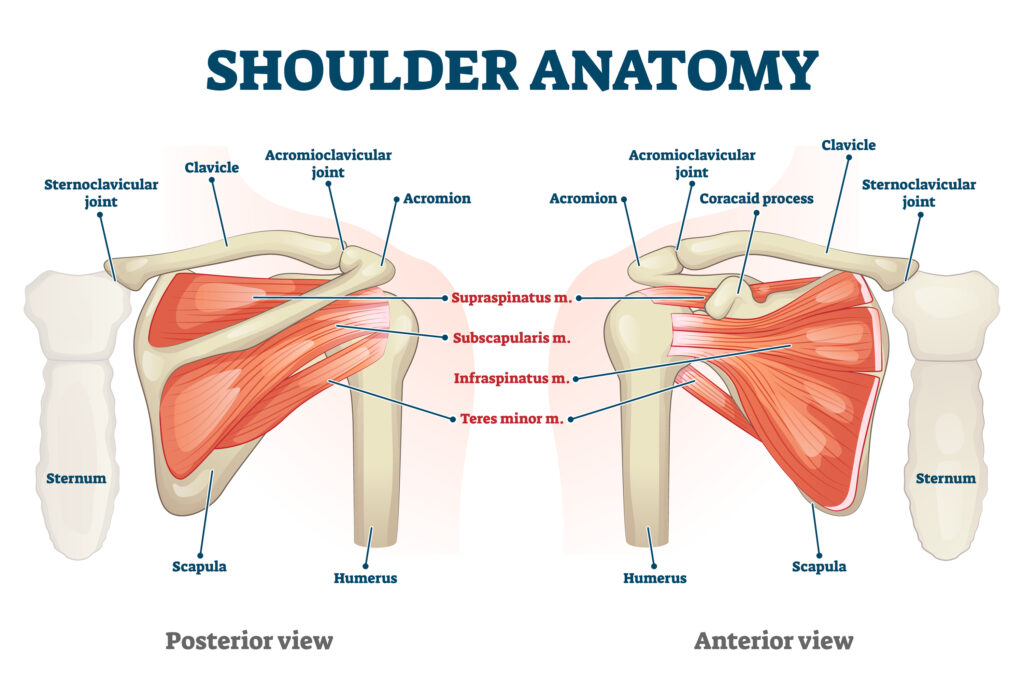Rotator Cuff pain is often caused by an inflamed, deteriorated, or torn rotator cuff tendon.
Associated discomfort(s) can be localised to the back, side, or rear of the shoulder and may often be described as dull and/or achy with possible occasional sharp shooting pains. On occasion, the pain can also refer to the outside portion of the upper arm and towards the elbow.
Interestingly, the intensity of the pain does not always correlate with the severity of the injury. So, a small cuff ‘injury’ could be quite painful, and a significant tear can present with a much lower grade pain.
Typically, people who are suffering from rotator cuff issues often struggle with:
- Overhead movement or activities.
- Side lifting of the arm.
- Sleeping on the affected side.
- Struggle to get their hand behind their back or head.
- Acute symptoms when bracing with the involved arm (i.e., supporting upper body weight against a surface like a table).
- Symptom irritation when carrying weights in a lower hanging position (e.g., shopping bag/toolbox)
What is the rotator cuff?
The shoulder is a very mobile joint i.e., it can perform a multitude of movements. It retains this high mobility in great part due to the fact that the socket of the shoulder joint is small and shallow which allows the upper arm bones head (the Humerus) high freedom (i.e., it is not restricted so much by a bony deep socket).
However, this movement freedom/lack of bony socket/security then means that the shoulder lacks stability (the ability to hold itself steady and well centralised/positioned).
Therefore, to maintain stability the shoulder has a specific set of deep muscles that facilitate and lead in this stability function. These muscles together are called ‘The rotator cuff’.
The name can initially be misleading; however, these muscles also support the rotation (twisting) functions of the shoulder as well. As a group they are, when healthy, very effective in simultaneously driving the shoulder twists and stability together.
Generally, the group consists of 4 muscles (Supraspinatus, Infraspinatus, Teres Minor and Subscapularis) whose main muscle bulk sits at the back of the shoulder attached to the shoulder blade. Their tendons reach to the upper arm bone (the Humerus) merging to form a ‘cuff’ like structure over the humeral head.
Sometimes when viewing the stability of the shoulder part of the arm bicep muscle would be included as this muscle assists with shoulder stability as well.

Causes of rotator cuff pain
Like many things, the greatest cause of rotator cuff injury is overuse. This often causes inflammation and irritation of the tendon, known as tendonitis.
Rotator cuff tendonitis is most prevalent in those who constantly stress the muscles with heavy overhead repetitive movement, such as:
- Weightlifters
- Swimmers
- Painters/decorators
- Plasterers
- Tennis players
- Cricket players
Other factors that can cause injury to the rotator cuff muscles are:
- Age
- Unfortunately, as we get older the risk of rotator cuff injury and tear increases, especially that of over 60:
- This is because the tendon weakens and calcifies over time, losing its elasticity and ability to deal with load.
- Therefore, it requires less stress and force to cause an injury – known as a degenerative tear.
- General health
- Those who are diabetic and/or overweight are at a higher risk of developing irritation of the rotator cuff tendon, which could lead to further injury.
- Trauma
- In severe causes the rotator cuff muscles can be torn by falling on an outstretched hand or lifting something too heavy. There is a varying degree of tears that can occur within the rotator cuff muscles, the most of which can be managed by physiotherapy.
Diagnosis
There are multiple tests that can be carried out by a qualified practitioner to establish the integrity and strength of your rotator cuff muscles. In some cases, whereby the practitioner believes imaging may be useful, an MRI scan can be requested to review the severity of a tear.
Other causes of shoulder pain can be seen below and should be ruled out on assessment:
- Frozen shoulder
- Shoulder impingement
- Labral tear
- Osteoarthritis
- Bicep’s tendinopathy
Treatment
Treatment will depend on the severity of the injury and should be advised by a qualified practitioner. However, generally, treatment for rotator cuff injuries can be seen below:
- Strength-based exercises
- A specific rehabilitation programme should be designed and tailored to you by a physio or sports therapist. This should aim to increase the strength and stability of the rotator cuff and surrounding shoulder muscles.
- Manual therapy
- Mobilisations to the shoulder and surrounding joints and spinal areas to prevent stiffness, thus enabling the muscles to work more optimally.
- Adjuncts to therapy
- Certain adjuncts such as shockwave therapy and ultrasound therapy can help with pain management and healing.
- In severe cases, a steroid injection may be given to help with the pain.
- Taping can also be used to provide the shoulder with support throughout the day or for sporting activities.
- Massage
- Massage can be significantly helping in helping to reduce pain and tone in tight or weak tissues, especially those that are injured.
- Lifestyle management
- Ensure to keep a healthy BMI
- Take adequate anti-inflammatories/pain medication to ensure sleep life balance is not affected
- Use ice/heat as required
- Rest
Are you suffering with a shoulder injury? Are you struggling to lift your arm? …. Think you are suffering from a rotator cuff injury? Book an assessment with a qualified physiotherapist or Osteopath here at Hempstead Therapy Centre
